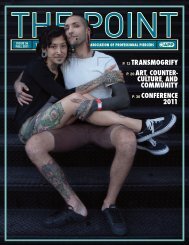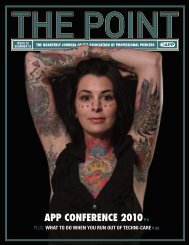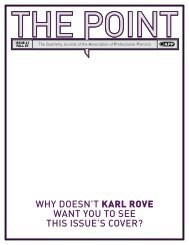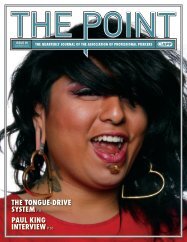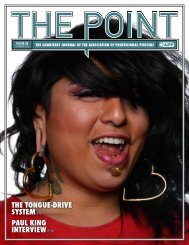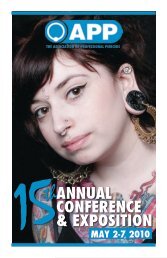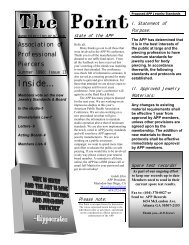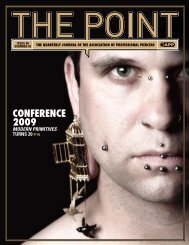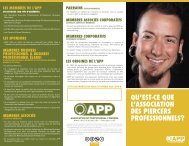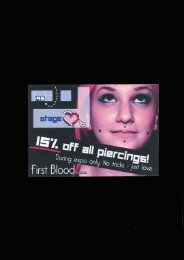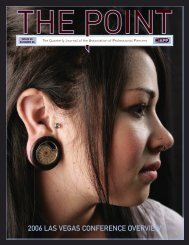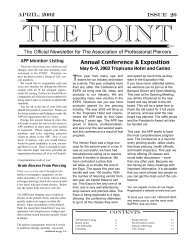the point - Association of Professional Piercers
the point - Association of Professional Piercers
the point - Association of Professional Piercers
You also want an ePaper? Increase the reach of your titles
YUMPU automatically turns print PDFs into web optimized ePapers that Google loves.
pieces may or may not have been connected. The o<strong>the</strong>r piece -- and<br />
most unique concept -- is one single piece that could be erected vertically<br />
and fits in both sides <strong>of</strong> <strong>the</strong> nose. It very well could have been<br />
made <strong>of</strong> ceramic or wood, but probably not stone, due to its weight. In<br />
order for a piece this size and style to sit up over <strong>the</strong> bridge <strong>of</strong> <strong>the</strong> nose<br />
would have to have been worn in a set <strong>of</strong> large gauge holes.<br />
Some very precious and delicate obsidian ear spools have been preserved<br />
for hundreds <strong>of</strong> years without a scratch. Why has this nostril<br />
piece not survived? There may be a few reasons why this piece <strong>of</strong> jewelry<br />
has never been seen or documented properly. It could very well<br />
have been made <strong>of</strong> fea<strong>the</strong>rs or ano<strong>the</strong>r degradable material that has not<br />
survived <strong>the</strong> test <strong>of</strong> time. Ano<strong>the</strong>r very real possibility is that it has been<br />
mistaken for ano<strong>the</strong>r type <strong>of</strong> artifact and has been placed in a completely<br />
different part <strong>of</strong> most museums’ archives. This is actually more<br />
common <strong>the</strong>n one might think. Out <strong>of</strong> <strong>the</strong> body, I imagine this piece<br />
looks like a tool <strong>of</strong> some sort, or possibly a child’s toy. It could also be<br />
mistaken for a simple ear plug. When an artifact doesn’t fit into <strong>the</strong><br />
school <strong>of</strong> knowledge <strong>of</strong> a particular archeologist, it <strong>of</strong>ten gets pushed<br />
aside or cataloged incorrectly. Ei<strong>the</strong>r way, and for whatever reason,<br />
THIS piece <strong>of</strong> jewelry is missing and not accounted for.<br />
I am in an intensive search for a piece that fits this description. I<br />
believe this nostril piece is a rare and undocumented piece <strong>of</strong> adornment<br />
so unusual in its wear that it is possibly unique among <strong>the</strong> world’s<br />
cultures. I have been to many <strong>of</strong> <strong>the</strong> largest Pre-Columbian collections<br />
throughout <strong>the</strong> U.S. and Mexico and have not seen or been able to find<br />
this piece. For <strong>the</strong> last few years I was unsure that this piece even existed,<br />
but after finding a few distinct three-dimensional representations<br />
in ceramic pottery, I am confident that this piece is out <strong>the</strong>re somewhere.<br />
I also suspect that because <strong>of</strong> <strong>the</strong> design <strong>of</strong> this jewelry, it may<br />
have broken so easily that it didn’t survive in its entirety. In Figures 3<br />
and 4, you can clearly see that <strong>the</strong>re is a person wearing a septum piece<br />
only, ano<strong>the</strong>r wearing a nostril and septum piece, and one with just <strong>the</strong><br />
nostril piece in question. In Figure 5 it is clear that <strong>the</strong>re was a piece<br />
being worn, but it has been broken from even this ceramic representation,<br />
giving us only a glimpse <strong>of</strong> its look and wear.<br />
Stumbling onto something never before written about is like finding<br />
a very important part <strong>of</strong> <strong>the</strong> historical puzzle. In a modern culture<br />
that is always re-defining beauty, it is exciting that a part <strong>of</strong> <strong>the</strong> past can<br />
reveal itself and give us a better understanding <strong>of</strong> our aes<strong>the</strong>tic history.<br />
In <strong>the</strong> last few years large gauge nostril piercing and stretching have<br />
become more common in <strong>the</strong> US. With <strong>the</strong>ir increasing popularity<br />
comes a desire to know <strong>the</strong> origins <strong>of</strong> <strong>the</strong>se practices, and <strong>the</strong> techniques<br />
and jewelry used to achieve and adorn <strong>the</strong>m. I am excited to<br />
present this information to you all, and to share at <strong>the</strong> Mexican APP<br />
Conference, I also had <strong>the</strong> opportunity to present this information to<br />
<strong>the</strong> Director <strong>of</strong> Archives at <strong>the</strong> Museo de Anthropologia in Mexico<br />
City. Director A. F. Josefina Bautista was invited to participate in <strong>the</strong><br />
APP Anthropology lecture by Danny Yerna. She has since expressed<br />
an interest in reviewing my research and helping with <strong>the</strong> search. With<br />
access to <strong>the</strong> Museo’s archives and <strong>the</strong> opportunity to look through<br />
some <strong>of</strong> its collections (o<strong>the</strong>r <strong>the</strong>n jewelry), I believe I could identify<br />
<strong>the</strong>se pieces. So this article is both an announcement, and a call out to<br />
any and all collectors or jewelry lovers: If you have a contribution to<br />
this search, please contact me. As individuals committed to and educated<br />
in <strong>the</strong> interaction <strong>of</strong> <strong>the</strong> jewelry and <strong>the</strong> body, both in <strong>the</strong> present<br />
and in <strong>the</strong> past, we are uniquely qualified to investigate and solve this<br />
historical mystery.<br />
Alicia Cardenas<br />
President@safepiercing.org.<br />
UPDATE ON<br />
OSHA’S RULING ON<br />
FREEHAND PIERCING<br />
Luis Garcia<br />
International Liaison<br />
Since my article in The Point #34 on <strong>the</strong> use <strong>of</strong> receiving<br />
tubes in freehand piercing technique, OSHA has passed an<br />
<strong>of</strong>ficial ruling on <strong>the</strong> subject. Piercing without an instrument<br />
to receive <strong>the</strong> needle (like a cork or receiving tube) is now considered<br />
a violation <strong>of</strong> Provision 29 CFR 1910.1030(d)(2)(i) <strong>of</strong><br />
<strong>the</strong> Bloodborne Pathogens Standard. This ruling is intended<br />
to protect <strong>the</strong> person handling <strong>the</strong> needle from needlesticks<br />
by minimizing potential contact with <strong>the</strong> contaminated end<br />
<strong>of</strong> <strong>the</strong> needle.<br />
Not only does this affect freehand piercers, but it also affects<br />
piercers that use forceps, but do not bed <strong>the</strong> needle tip in<br />
a cork or o<strong>the</strong>r device during jewelry insertion. While it may<br />
not seem as dangerous as freehand piercing, leaving <strong>the</strong> needle<br />
unbedded does increase <strong>the</strong> risk <strong>of</strong> a needlestick to a level<br />
comparable to that <strong>of</strong> freehand piercing without a receptacle.<br />
As <strong>the</strong> body piercing industry continues to grow, and continues<br />
to permeate popular culture, we need to make a concerted<br />
effort to abide by OSHA’s recommended guidelines.<br />
In doing so, we facilitate OSHA’s continued support <strong>of</strong> our<br />
industry. No matter what anyone thinks, <strong>the</strong> cooperation<br />
<strong>of</strong> organizations like OSHA will come in handy when local<br />
governments try to pass regulations on body piercing. Our<br />
compliance will help stop outright banning <strong>of</strong> body piercing,<br />
and will help include pr<strong>of</strong>essional piercers in <strong>the</strong> creation <strong>of</strong><br />
regulations. A small adjustment in daily procedure is a minor<br />
price to pay to keep our pr<strong>of</strong>ession.<br />
To view <strong>the</strong>se documents,<br />
go to www.hl<strong>the</strong>du.com under OSHA Interpretations.<br />
ISSUE 35 T H E P O I N T 7



